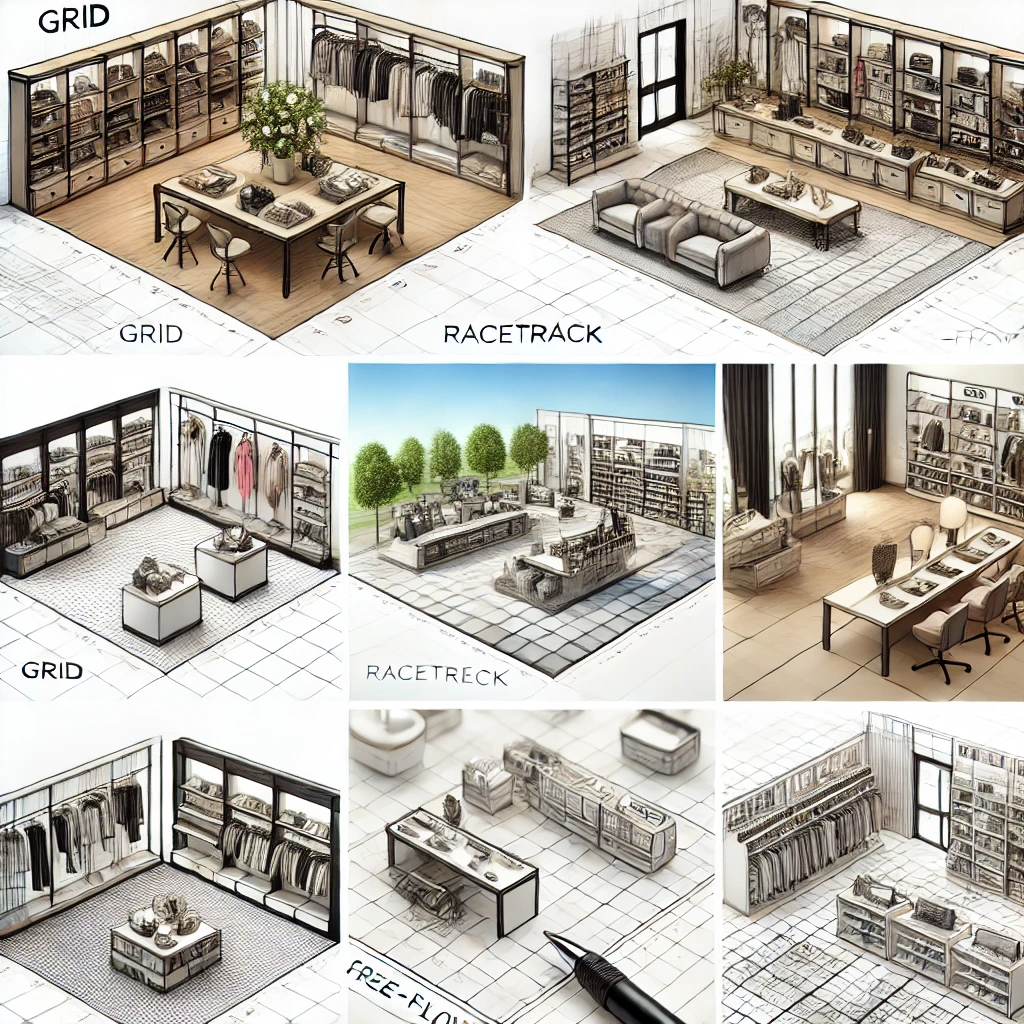Retail Store Layout: 10 Ideas, Examples & Tips
Starting a retail store in 2025 requires careful planning, budgeting, and a solid understanding of operational expenses. Whether you’re launching a brick-and-mortar shop or integrating online sales, knowing the costs involved can help you set realistic expectations and financial goals. In this guide, we’ll break down the essential expenses and factors affecting the cost of opening a retail store in 2025

Introduction
A well-designed retail store layout can significantly impact customer experience, sales, and brand perception. Whether you’re launching a new store or revamping your existing setup, choosing the right layout is crucial. In this guide, we’ll explore ten effective retail store layout ideas, provide real-world examples, and share expert tips to optimize your space for maximum engagement and conversions.
1. Grid Layout
Best for: Grocery stores, pharmacies, convenience stores
The grid layout is one of the most common retail store designs. It features parallel aisles that allow for easy navigation and maximum product exposure.
Example:
Supermarkets like Walmart use this layout to maximize product visibility and customer movement.
Tip:
Place high-margin items at eye level to boost sales.
2. Loop (Racetrack) Layout
Best for: Department stores, large retail stores
This layout guides customers along a predetermined path, ensuring they pass by various product categories before reaching the checkout.
Example:
IKEA effectively uses a racetrack layout to take customers through different sections while displaying various product arrangements.
Tip:
Use clear signage and strategically place promotional items along the path.
3. Free-Flow Layout
Best for: Boutique stores, specialty shops
The free-flow layout allows customers to wander freely without any rigid aisle structure. It creates a relaxed shopping atmosphere and encourages exploration.
Example:
High-end fashion boutiques often use this layout to create a luxurious feel.
Tip:
Ensure enough open space to avoid clutter and create a seamless shopping experience.
4. Angular Layout
Best for: High-end stores, jewelry shops
This layout uses curves and soft angles to create a premium and sophisticated shopping experience.
Example:
Luxury brands like Louis Vuitton incorporate angular layouts to enhance product presentation.
Tip:
Use high-quality displays and lighting to highlight premium products.
5. Herringbone Layout
Best for: Small retail spaces, bookstores
This design features diagonal aisles, making it a great choice for maximizing product exposure in narrow spaces.
Example:
Independent bookstores and small fashion boutiques often adopt this layout for a cozy shopping experience.
Tip:
Keep pathways clear to ensure smooth traffic flow.
6. Diagonal Layout
Best for: Electronics stores, hardware shops
A diagonal layout improves store navigation and visibility by placing shelves at an angle to create an open feel.
Example:
Tech retailers like Best Buy use this layout to make product browsing easier.
Tip:
Position key products at the entrance to draw customers in.
7. Spine Layout
Best for: Specialty stores, salons
A central aisle (spine) runs through the store with smaller product sections branching off.
Example:
Beauty salons and organic product stores often use this layout to enhance the browsing experience.
Tip:
Use engaging displays along the spine to maintain customer interest.
8. Mixed Layout
Best for: Large retail stores, department stores
This layout combines multiple elements from different layouts to create a dynamic shopping experience.
Example:
Department stores like Macy’s utilize a mix of grid and free-flow layouts for flexibility.
Tip:
Use analytics to determine customer traffic patterns and adjust accordingly.
9. Boutique Layout
Best for: Luxury and high-end brands
A boutique layout creates separate sections for different product categories, making shopping feel more exclusive.
Example:
Fashion brands like Chanel use boutique-style layouts to enhance the customer experience.
Tip:
Maintain a minimalist approach to emphasize high-value products.
10. Showroom Layout
Best for: Furniture, automotive, and appliance stores
This layout focuses on creating immersive product displays where customers can interact with items before purchasing.
Example:
Tesla showrooms allow customers to explore vehicle models before ordering online.
Tip:
Use digital kiosks to enhance customer engagement and provide additional information.
Conclusion
Choosing the right retail store layout depends on your business type, target audience, and available space. By implementing these layout ideas, you can create an optimized shopping experience that enhances customer satisfaction and boosts sales.
Need Help Designing Your Retail Store?
If you’re looking for expert guidance on setting up your Shopify store or optimizing your retail space, eStoresmaker can help! Contact us today to get started.
Hire Best Shopify Expert

With over 5+ years of experience in Shopify and WordPress, a 100% job success rate as well and a wide range of front-end and back-end experts.
Latest Posts
-
5 Ways to Keep Your Upwork Client Long-Term in 2025
April 17, 2025 -
5 Reasons to Build Your Online Store in Shopify
March 28, 2025 -
Top 5 Strategies to Build Your Dream E-Commerce Business with Shopify in 2025
March 24, 2025 -
Shopify Theme Development & How to Hire the Best Freelance Shopify Developer on Upwork in 2025
March 5, 2025 -
How to Build and Transfer a Shopify Development Store
February 23, 2025 -
Retail Store Layout: 10 Ideas, Examples & Tips
February 13, 2025 -
How Much It Costs to Open a Retail Store in 2025
February 6, 2025 -
The Future of E-Commerce: How to Grow Your Shopify Store in 2025
February 3, 2025 -
The Future of Dropshipping in 2025: Trends Every Shopify Store Owner Should Watch
February 2, 2025 -
2025 E-Commerce Trends: What Shopify Store Owners Need to Know
February 1, 2025